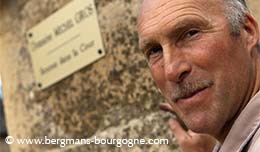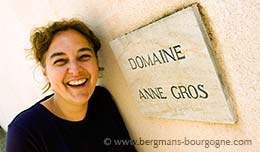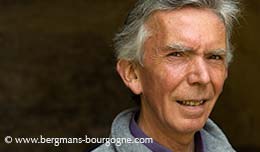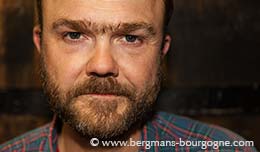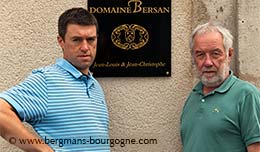
arsannay is my village, but frankly, it is also the village which has improved the most in terms of quality over the past 30 years.
Bruno Clair has been running the domaine that carries his name since 1979. He is pleased with how things have turned out for the Marsannay appellation, the work of the younger generation and the prospect of having some vineyards upgraded to premier cru status in a not too distant future.
 – I think we have a very strong case for the premier crus, he says.
– I think we have a very strong case for the premier crus, he says.
The premier cru project was initiated back in 2002 and there is still some time left before the INAO, the wine appellations governing body, will make their decision. Meanwhile, the growers of the village continue their work to improve the Marsannay appellation.
– There has been a change of generation in Marsannay, continues Bruno Clair. Now you have people here who have decided not to do as their fathers, who sold most of their production to the négociants. They were happy to sell it as appellation Bourgogne at a certain price. When the Marsannay appellation arrived, with lower maximum yield, they chose to continue selling it as Bourgogne. The younger generation decided to stop all that. They stopped selling to négociants and began bottling themselves.
 With its origins going back to Domaine Clair-Daü Bruno Clair’s estate has grown from seven hectares to a total of 24 hectares today, stretching over seven villages from Marsannay to Savigny-lès-Beaune. There are a number of Marsannay cuvées, as well as three grand crus – Corton-Charlemagne, Clos de Bèze and Bonnes Mares.
With its origins going back to Domaine Clair-Daü Bruno Clair’s estate has grown from seven hectares to a total of 24 hectares today, stretching over seven villages from Marsannay to Savigny-lès-Beaune. There are a number of Marsannay cuvées, as well as three grand crus – Corton-Charlemagne, Clos de Bèze and Bonnes Mares.
– If Marsannay gets its premier crus there is no doubt that Longeroies and Clos du Roi will be the first ones, says Bruno Clair.
At Domaine Bruno Clair three Marsannay lieux-dits have been singled out – Longeroies, Grasses Têtes and Vaudenelles. These are three wines with distinctly different characteristics. Vaudenelles is the one with the least ageing potential. Planted on almost white soil this is a light and fruity wine.
 – Grasses Têtes is mid slope, explains Bruno Clair. The name refers either to Grosses Têtes – ”big rocks” – or to Grasse Terre – ”rich soil”. You have very compacted clay there. It is rich in iron and the clay is red. The wine is not very easy to taste when young, but the potential for ageing is superb.
– Grasses Têtes is mid slope, explains Bruno Clair. The name refers either to Grosses Têtes – ”big rocks” – or to Grasse Terre – ”rich soil”. You have very compacted clay there. It is rich in iron and the clay is red. The wine is not very easy to taste when young, but the potential for ageing is superb.
– Longeroies is perhaps the most well-balanced wine in Marsannay. It’s not as ultra-powerful as the Grasses Têtes, but instead you have something very homogenous and very well-balanced. You don’t find this balance in a young Grasses Têtes, but in a mature one you definitely have it. You need to keep Grasses Têtes for ten years, which is very long for a Marsannay. Longeroies on the other hand is easy to drink young and it’s easy to drink when it’s mature.
 The main part of Bonnes Mares is in Chambolle-Musigny, but about ten per cent, the northernmost part, spills over into Morey-Saint-Denis. This is where the parcel of Domaine Bruno Clair is located, half of it planted in 1946 and half in 1980.
The main part of Bonnes Mares is in Chambolle-Musigny, but about ten per cent, the northernmost part, spills over into Morey-Saint-Denis. This is where the parcel of Domaine Bruno Clair is located, half of it planted in 1946 and half in 1980.
– Compared with Clos de Bèze this is a completely different planet. Our Bonnes Mares is more like Clos de Tart than the Bonnes Mares of Domaine de Voguë, which is at the other end. The soil is very different. We are next to Clos de Tart. You have clay at the bottom and white soil at the top. Like in Chambertin, Cazetiers and Clos Saint-Jacques the rows in Bonnes Mares go from the bottom to the top. You always have finesse at the top of the slope and power at the bottom, so the ideal thing is to have both. A Bonnes Mares from the Morey side usually has a bit more power than the ones from the Chambolle side, which are more about finesse.
 Above Bonnes Mares you’ll find parcels of both Chambolle-Musigny – Veroilles – and Morey-Saint-Denis – En la Rue de Vergy – which Bruno Clair cleared and planted in the 1980s and the 1990s. After the phylloxera these parts had been abandoned, mainly because of the difficulties to work up there.
Above Bonnes Mares you’ll find parcels of both Chambolle-Musigny – Veroilles – and Morey-Saint-Denis – En la Rue de Vergy – which Bruno Clair cleared and planted in the 1980s and the 1990s. After the phylloxera these parts had been abandoned, mainly because of the difficulties to work up there.
– There is not much soil at all up there, says Bruno Clair. The rock was broken up with dynamite and then the roots had to find their way down. It took quite some time, but today the vines don’t suffer in dry years.
In Chambolle-Musigny only pinot noir is allowed, but in Morey-Saint-Denis the En la Rue de Vergy parcel was split in two, with half planted with pinot noir and half with chardonnay.
 – Morey-Saint-Denis is a red village, but poor soil is perfect for chardonnay, so I decided to plant some chardonnay in En la Rue de Vergy. I had one hectare to plant there, which is a lot for a Burgundian, so I decided to have both red and white.
– Morey-Saint-Denis is a red village, but poor soil is perfect for chardonnay, so I decided to plant some chardonnay in En la Rue de Vergy. I had one hectare to plant there, which is a lot for a Burgundian, so I decided to have both red and white.
– Initially the wines were a bit light, but as the roots reached further down things improved. It took something like 15 years for the red to gain structure. The white became interesting at an earlier stage, maybe after six years. Altogether it was a very demanding project, getting those vineyards back in shape. Today, at my age, I wouldn’t do it.
In recent years the next generation has joined Bruno Clair at the domaine. His oldest son, Edouard, began converting the vineyards to organic six years ago. Arthur, his youngest son, joined in for this interview and will probably focus more on the work in the cellar.
Apart from the grand cru Clos de Bèze in Gevrey-Chambertin Domaine Bruno Clair also has several premier crus there – Petite Chapelle, Cazetiers, Clos Saint-Jacques and the monopole of the domaine, Clos du Fonteny.
– Clos du Fonteny is the top part of Fonteny, says Arthur Clair. It’s next to Ruchottes-Chambertin. As a wine it is more delicate than powerful. It’s the Chambolle of Gevrey. Not much soil there. You are very close to the rock.
– Cazetiers and Clos Saint-Jacques are interesting to compare because they were planted at the same time by my father, continues Bruno Clair. In Cazetiers you have white marl at the top and compacted clay at the bottom. Clos Saint-Jacques is more traditional clay. My father planted a lot in the 1950s and 1960s.
© 2019 Ola Bergman










